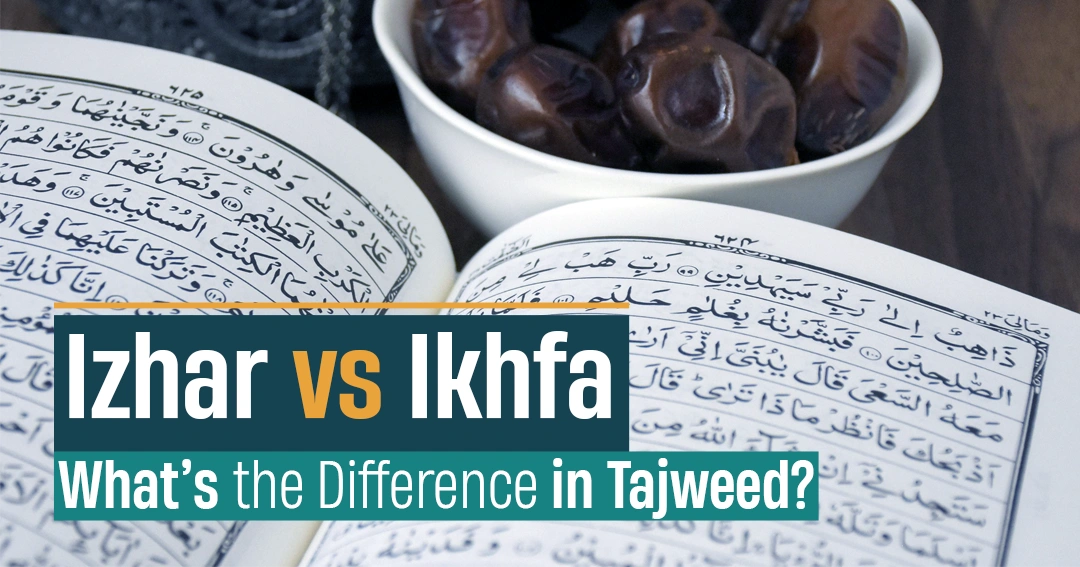If you’re seeking to master Izhar vs Ikhfa, then it’s important to understand the difference between the two fundamental Tajweed rules.
Both rules deal with the pronunciation of Nun Sakinah or Tanween, but each is different, Izhar requires distinctness, whereas Ikhfa is a soft nasal sound.
Whether you’re a beginner or seeking to refine your recitation, knowing how and when to apply these rules will significantly enhance the accuracy and beauty of your Quranic recitation.
Understanding Izhar in Tajweed

When learning Tajweed, it’s important to learn the difference between Izhar vs Ikhfa. Izhar is translated to “clarity” or “to make clear,” and that’s exactly what this rule is all about, clear and exact pronunciation without nasalization.
For those students who want to recite the Quran correctly, being familiar with Izhar is essential to uphold the meaning and rhythm of the verses.
What is Izhar in Tajweed?
In Tajweed, Izhar is the rule applied when a Nun Sakinah (نْ) or Tanween (ً ٌ ٍ) comes before one of the six throat letters:
ء (Hamzah), ه (Ha), ع (Ayn), ح (Ha), غ (Ghayn), خ (Kha).
Whenever one of these letters comes after Nun Sakinah or Tanween, the nun sound is articulated in its pure form without nasalization or mixing.
This clarity is that which distinguishes Izhar from being part of the Izhar vs Ikhfa rule set. It ensures that each letter is pronounced from its authentic articulation point, especially when reciting at fluency and accuracy.
Examples of Izhar in the Quran
To practice Tajweed perfectly, it’s essential to listen and repeat examples. Consider the following verse, for example:
مِنْ عِلْمٍ
Min ‘ilmin – The letter following Nun Sakinah here is ‘Ayn (ع), an Izhar letter. The “n” sound is said distinctly before moving to the ‘Ayn.
It’s good to understand such examples in the context of Izhar vs Ikhfa rules so that the memory muscle in your pronunciation is developed well while repeating verses for memorization or during Salah.
Common Mistakes in Applying Izhar
The majority of new students unknowingly blend the nun sound with the following letter to create an Ikhfa-like sound.
his blurring disrupts the clarity required in Izhar, affecting the integrity of the recitation. Identifying the distinction between Izhar vs Ikhfa is what allows you to apply each rule efficiently and avoid such mistakes.
Understanding Ikhfa in Tajweed

The next of the Izhar vs Ikhfa rule set that you will need to learn is Ikhfa. Ikhfa means literally “to conceal” or “to hide,” which is the opposite of Izhar.
Instead of pronouncing the Nun Sakinah or Tanween, Ikhfa is a soft blending of the sound of the nun into the next letter, and also a nasal sound known as ghunnah.
What is Ikhfa in Tajweed?
Ikhfa in Tajweed occurs when a Nun Sakinah or Tanween is followed by one of 15 specific letters that are not throat letters (used in Izhar) nor the Idgham nor Iqlab letters. This causes a partially “n” sound, which is extended for about two counts through the nose.
This soft blending is what distinguishes Ikhfa in the Izhar vs Ikhfa comparison. Unlike Izhar, which is all about being clear, Ikhfa requires subtlety and control in your recitation, especially when producing the ghunnah sound properly.
Examples of Ikhfa in the Quran
Let’s look at an example from the Quran:
مِنْكُم
Minkum – In this instance, the letter that comes after the Nun Sakinah is Kaaf (ك), one of the 15 Ikhfa letters. The “n” sound isn’t entirely pronounced and not at all dropped, it’s hidden with nasalization before slipping into the Kaaf.
Repeating such as these is the secret to gaining mastery over Ikhfa, and understanding Izhar vs Ikhfa sets you in a much better position to use the right rule within the Izhar vs Ikhfa system.
The Application of Ghunnah to Ikhfa
One of the unique features of Ikhfa is ghunnah, the nasalized vowel produced when the nun is covered. It’s a subtle but essential distinction many students overlook. Misusing it alters the meaning of a word and affects the fluency of your recitation.
Understanding these facts and how they distinguish Ikhfa from Izhar is what makes your knowledge of Izhar vs Ikhfa unique and improves your overall Tajweed usage.
Izhar vs Ikhfa – Key Differences
Now that you’ve got an overall idea of Izhar and Ikhfa, it’s now time to visualize them side-by-side. Visually comparing Izhar vs Ikhfa directly shows the basic differences.
This is something to keep in mind when implementing the proper rule at recitation in the Quran with ease and confidence. The side-by-side comparison will facilitate better understanding and highlight general misconceptions.
What Sets Izhar and Ikhfa Apart in Tajweed?
Even though both of them involve Tanween and Nun Sakinah, how they’re pronounced and with which letter they begin is all different.
The most crucial difference between Izhar vs Ikhfa is openness and hiding. Izhar requires open pronunciation without nasalization, while Ikhfa requires half-concealment with a nasal voice.
Here’s a table to illustrate the difference between Izhar and Ikhfa:
| Feature | Izhar | Ikhfa |
| Meaning | To make clear | To hide or conceal |
| Number of Letters | 6 throat letters (ء، هـ، ع، ح، غ، خ) | 15 letters (excluding throat, Idgham, and Iqlab letters) |
| Pronunciation | Clear and complete nun or tanween sound | Hidden nun or tanween sound with nasalization |
| Ghunnah (nasal sound) | Not applied | Required (2 counts) |
| Articulation | From the throat (makhraj of the following letter) | Blended softly with the following letter |
| Example | Min ‘ilmin (مِنْ عِلْمٍ) | Minkum (مِنْكُمْ) |
How to Remember When to Use Izhar vs Ikhfa
An easy trick for memorizing how to use Izhar vs Ikhfa is to notice the letter after the Nun Sakinah or Tanween. If it is a throat letter, do Izhar. If it is one of the 15 letters of Ikhfa, use the nasal combination of Ikhfa.
Drilling, listening to skilled reciters, and continuous correction are necessary to be proficient in this technique.
How to Practice Izhar and Ikhfa

Practicing Izhar vs Ikhfa accurately is key to enhancing your recitation of the Quran, and although it may appear to be tough at first, consistency and a proper approach will result in mastery.
In this section, we will give you some practical tips to help you practice these Tajweed rules easily, allowing your recitation to become not only accurate but also beautiful.
1. Understand the Basics Before You Start
Before jumping into practice, it’s important to understand the rules for both Izhar vs Ikhfa. As mentioned above, Izhar demands distinct pronunciation of the nun sound followed by throat letters (ء، هـ، ع، ح، غ، خ), whereas Ikhfa demands soft combination of the nun sound followed by one of the 15 Ikhfa letters, with nasalization (ghunnah).
Begin by going through these rules and examples to understand the differences. Knowing when to use Izhar vs Ikhfa will enhance your practice significantly.
2. Listen to Proficient Reciters
One of the best ways to improve your Tajweed is by listening to good reciters of the Quran who pronounce Izhar vs Ikhfa perfectly. Give serious attention to the way they apply the rules, observing how they make the nun audible in Izhar and quiet in Ikhfa with the correct nasal tone.
Make it a daily habit by listening to Quran recitations during Salah, memorization, or through online media. Repetition is the key to developing a muscle memory for proper pronunciation.
3. Practice with Simple Verses
Practice Izhar vs Ikhfa using short, simple verses that have Nun Sakinah or Tanween followed by the respective letters. This will enable you to master your pronunciation while making your practice sessions easy.
For example, practice with these phrases:
Izhar Example: مِنْ عِلْمٍ (Min ‘ilmin)
Ikhfa Example: مِنْكُمْ (Minkum)
Repeat each verse multiple times, ensuring that you’re correctly applying either the clear sound of Izhar or the hidden, nasalized sound of Ikhfa.
4. Record Yourself and Compare
A great way to test your improvement is by taking an audio recording of your recitation and comparing it with a good teacher’s recitation. Listen very carefully to whether you’ve pronounced the nun sound properly in Izhar or incorporated a nasal tone into it in Ikhfa.
It will be able to identify areas that require correction and track your improvement. You’ll be able to notice minor improvements in your recitation if you practice regularly.
5. Get Feedback from a Teacher
One-to-one feedback from an experienced teacher can greatly accelerate your learning process. A teacher will lead you to recognize mistakes that you might struggle to identify by yourself, particularly in the case of Izhar vs Ikhfa.
If you require guidance, Tareequl Jannah Academy offers online lessons from professional Tajweed tutors who can guide you through your practice, rectify mistakes in real-time, and provide personalized advice to help make your recitation flawless.
6. Be Consistent and Patient
Mastering the complex rules of Izhar vs Ikhfa takes time. Set aside daily time for focused Tajweed practice, starting with a few minutes and increasing gradually as you improve. The more consistent you are, the quicker you’ll see improvement.
Remember that patience is key, it’s only normal to feel strained at first, but with dedication and regular practice, your recitation will improve over time.
Conclusion
Understanding the difference between Izhar vs Ikhfa is key to elevating your Quran recitation. By adhering to these rules correctly, you render your recitation both accurate and beautiful and remain true to the divine message.
With determination and correct guidance offered by Tareequl Jannah Academy, you can implement these Tajweed rules confidently and elevate your recitation to the next level. Practice today itself, and enjoy the sweetness of reciting the Quran with perfect Tajweed.




